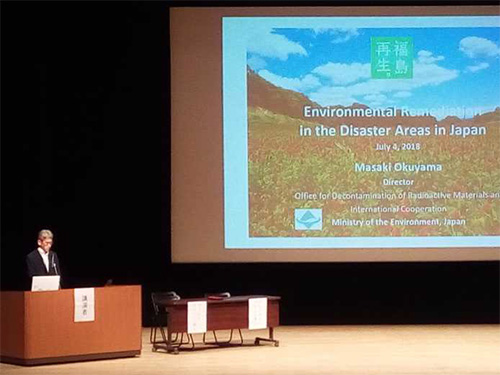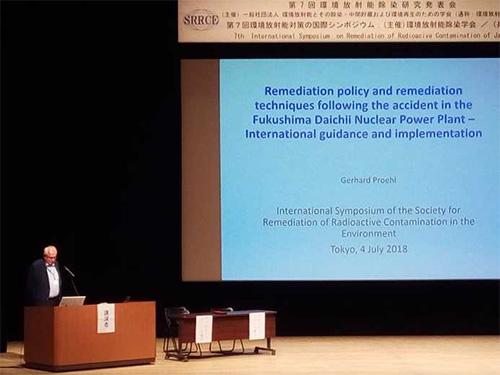International Symposium on Remediation of Radioactive Contamination in the Environment
DATE: July 4, 2018
The "International Symposium on Remediation of Radioactive Contamination in the Environment" was held at the Tower Hall Funabori in Edogawa-ku, Tokyo, on Wednesday, July 4, 2018. It was sponsored by the Society for Remediation of Radioactive Contamination in Environment (SRRCE) and co-sponsored by the Ministry of the Environment, Japan (MOE).
This symposium was held in conjunction with the seventh research presentation conference of SRRCE. Invited speakers included Dr. Gerhard Proehl, former Head of the Assessment and Environmental Management Unit, Division for Nuclear Safety and Security, International Atomic Energy Agency (IAEA), Dr. Vasyl Yoschenko, Project Professor of Institute of Environmental Radioactivity of Fukushima University, Mr. Masaki Okuyama, Director of Office for Decontamination of Radioactive Materials and International Cooperation, Environmental Regeneration and Material Cycles Bureau, Japan’s Ministry of the Environment.
At the symposium, first, Mr. Okuyama, on completion of whole area decontamination projects, explained the outline and achievements of decontamination projects in Fukushima Prefecture, the outline and current status of interim storage facilities and volume reduction facilities for removed soil, etc. and the outline of communication and cooperation with residents and the international community.

Next, Dr. Proehl explained mainly the target values adopted in these decontamination projects in comparison with the safety standards for remediation at IAEA and target values for decontamination of other countries. In conclusion, the safety standards for decontamination set up by the Ministry of the Environment this time were explained to be equivalent or safer compared to the IAEA and other countries. There were comments about future improvements regarding the evaluation stage of the decontamination and the overall cost-effectiveness analysis of projects, etc. Also, he mentioned that the communication and cooperation with residents were generally successful.

Next, Dr. Yoschenko explained the pollution situation, scale, and forestry values, etc. regarding radiation-contaminated forests in Fukushima Prefecture. The concentrations and dynamics of radioactive cesium in the forest were explained together with research results at Chernobyl. Regarding future decontamination of forests in Fukushima Prefecture, he emphasized the importance of correctly establishing target standards with consideration of the relation between forestry values and decontamination costs, in cooperation with stakeholders.

Finally there was a question-and-answer session with participants, relating mainly to safety standards etc. for timber use of contaminated forests, etc.